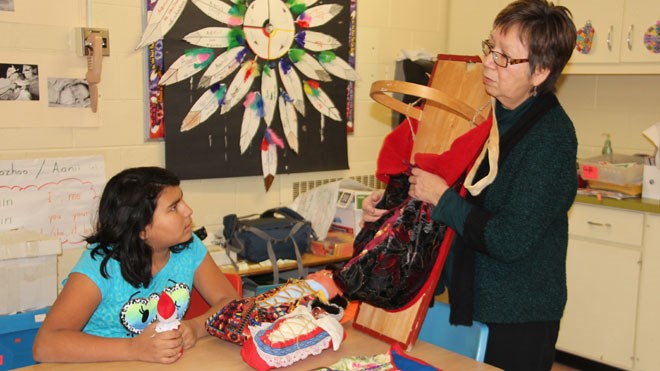For Katelyn Moore, learning Ojibwe is something that brings to mind family.
The Grade 7 Lansdowne Public School student has Cree roots. She grew up hearing her grandparents speaking the language, although she didn't understand what they were saying.
But 12-year-old Moore said to her ear, the two Aboriginal languages are similar.
“It kind of feels like home, when I speak like that,” she said.
Aboriginal culture is something that's very much present at Katelyn's inner-city school, which has a high population of First Nation, Metis and Inuit students.
The hallways have Ojibwe names, and Katelyn and her peers recently worked on six murals depicting animal clans with Espanola-based artist Michael Cywink — a project she very much enjoyed.
“I want to know more about my culture and what my ancestors did,” Katelyn said.
In the Rainbow District School Board, Ojibwe language classes are available at 13 of the board's elementary schools, and seven of its secondary schools.
It's taught to all students at these schools up to Grade 3, and older students have a choice between studying French or Ojibwe.
The Ojibwe classes — along with other programs which infuse Aboriginal culture into the classroom — are part of the board's strategy to improve achievement among Aboriginal students.
It's a goal that's crucial, said Kathy Dokis, principal of First Nations, Metis and Inuit education with the Rainbow board, given achievement gaps revealed by Education Quality and Accountability (EQAO) tests.
Aboriginal students attending Rainbow schools score, on average, between 13 to 21 per cent lower on the provincial standardized tests compared to the board's overall results, she said.
When compared to the provincial EQAO average among Aboriginal students, Rainbow's Aboriginal population scored two to six per cent lower.
Dokis said it's her dream to not only close those gaps, but ensure Aboriginal students excel.
“We did see some slight increases in some of our primary and junior results this year, so that was good news,” she said.
Six years ago, the province came out with its First Nations, Metis and Inuit framework, which is aimed at better serving Aboriginal students. Dokis headed up the framework's implementation at the Rainbow board.
The board is in the process of training its teachers to be able to infuse Aboriginal culture into the curriculum, she said.
Rainbow also funds programs such as Raven at Espanola High School, which offers a mix of intensive academic support and Aboriginal cultural training to students at risk of dropping out of high school.
An alternative school at N'Swakamok Native Friendship Centre in the city's downtown allows Aboriginal students who don't thrive in a traditional high school atmosphere a chance at graduating.
These types of initiatives are important, because when students see themselves reflected at school, they feel valued, which leads them to become more engaged in learning, said Dokis.
“When students are more engaged, it's obviously going to impact their achievement, if they're participating more fully,” she said.
Such programming also engages the students' parents, which is important, because of historic mistrust between Aboriginal communities and the education system stemming from the residential school legacy, Dokis said.
Lansdowne's Ojibwe teacher, Linda Manitowabi, spends her days teaching students songs in the language, playing games with them and teaching them about various aspects of Aboriginal culture.
During Northern Life's recent visit to the school, she taught her Grade 4 students about how cradleboards are used to carry infants.
She said she doesn't expect the children will become fluent in the language, but still thinks they're being given something precious — a sense of what it means to be Aboriginal.
“They probably would expect it on the reserve, but when they're in the city, it makes it even more special,” Manitowabi said.
Stan Peltier, who teaches Ojibwe at Queen Elizabeth Public School, said the key to teaching children to speak the language is to teach them the rich cultural meanings entrenched in the words.
The Ojibwe word for truth, for example — Debwewin — means at its roots “what comes from your heart.”
“All our history and culture is still intact in our words,” said Peltier, who also gives elder teachings at all of the board's schools.
“If you lose that then they would have achieved the goal that the government would have wanted to do in assimilating First Nations.”
Learning such cultural values is important for Aboriginal kids, he said.
“It's going to make them better people, plus they're going to feel proud of who they are, not marginalized,” Peltier said.
@heidi_ulrichsen
